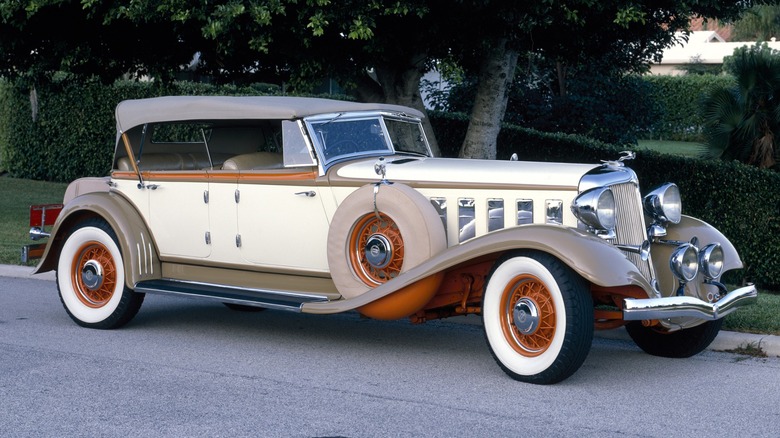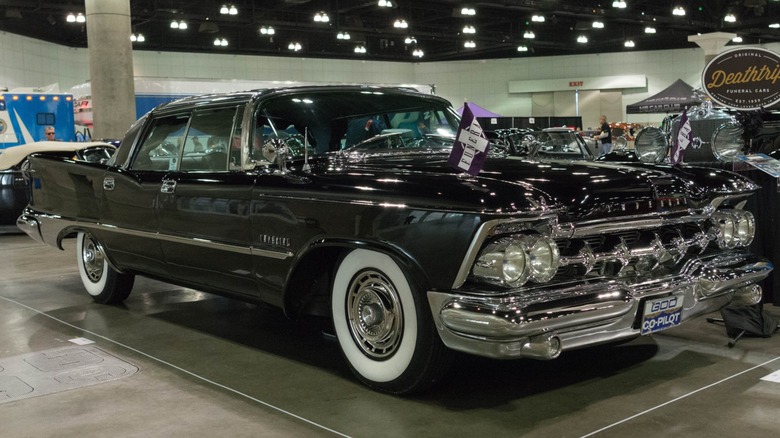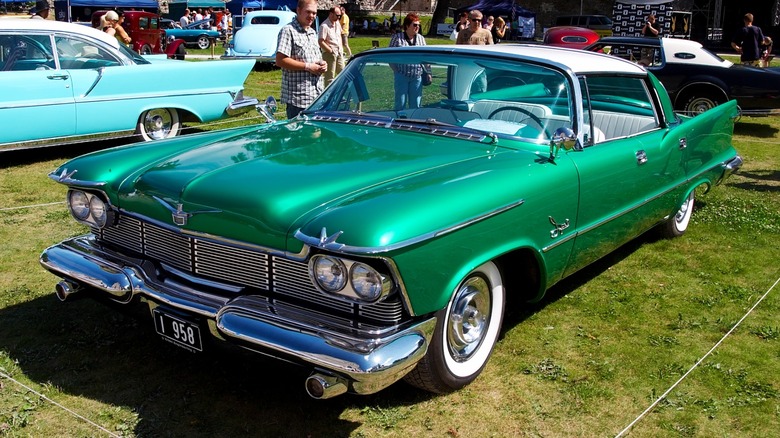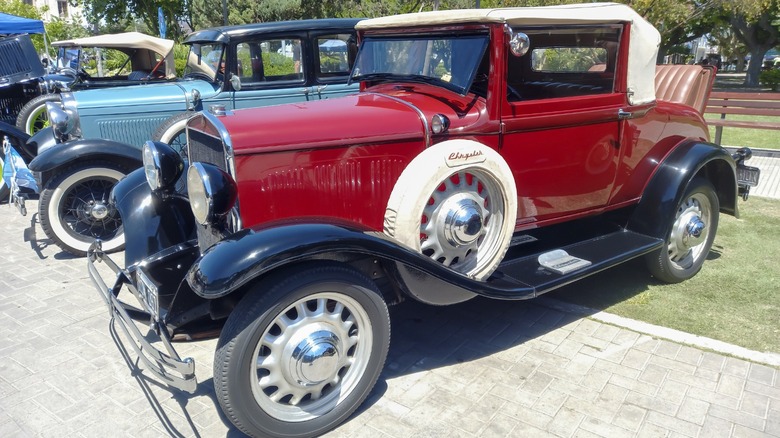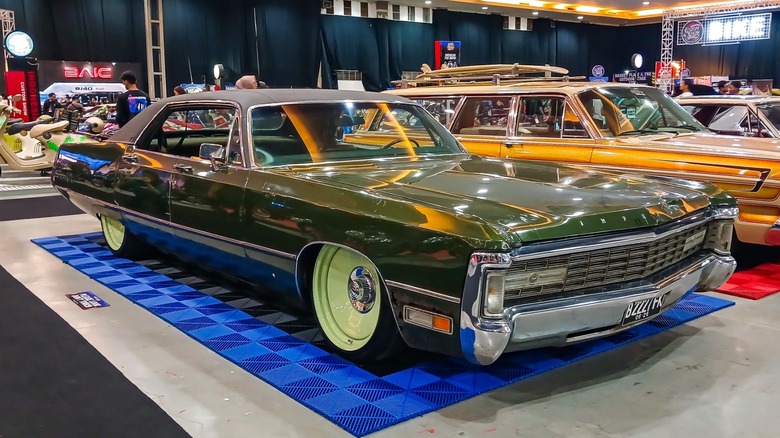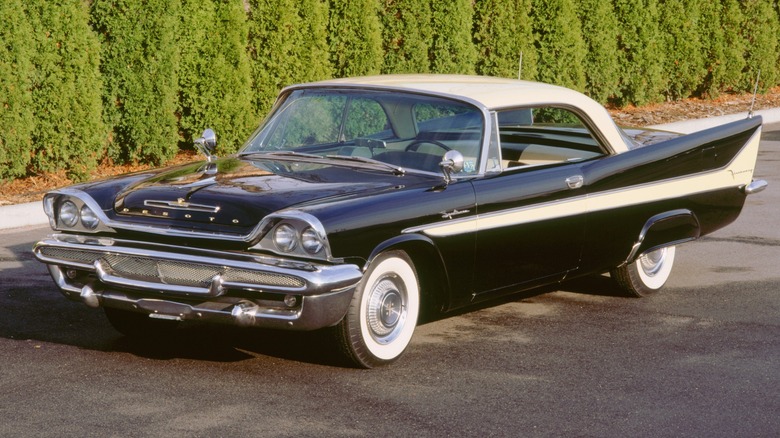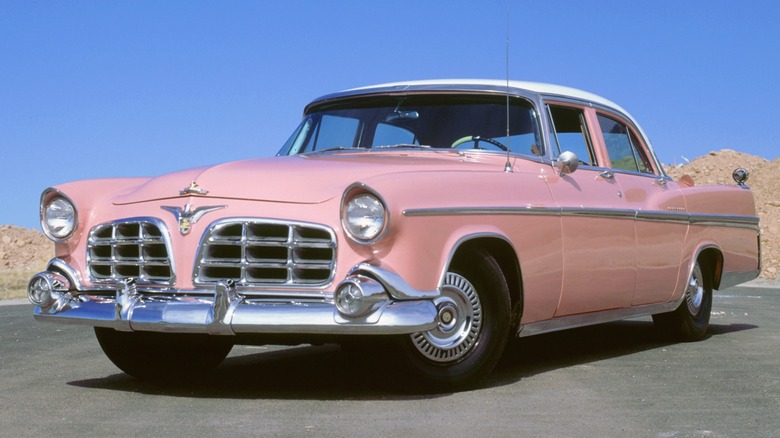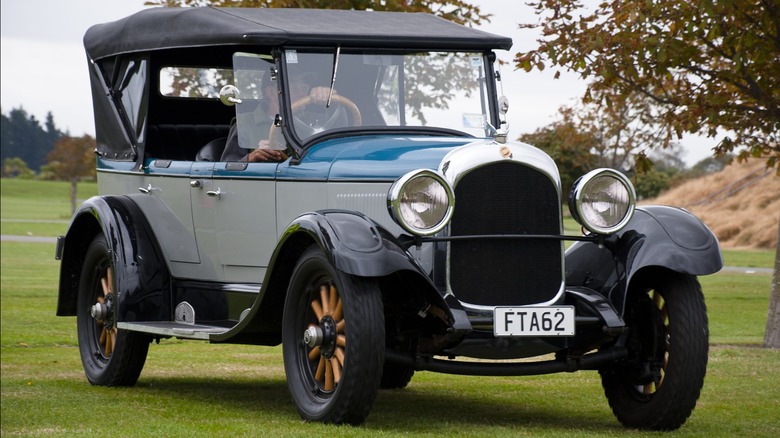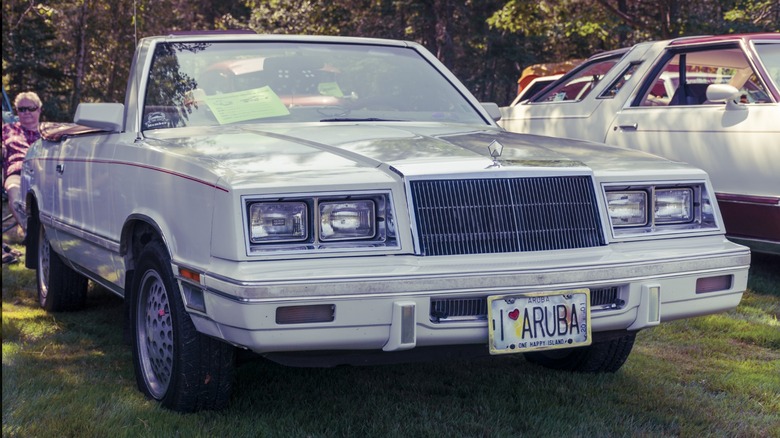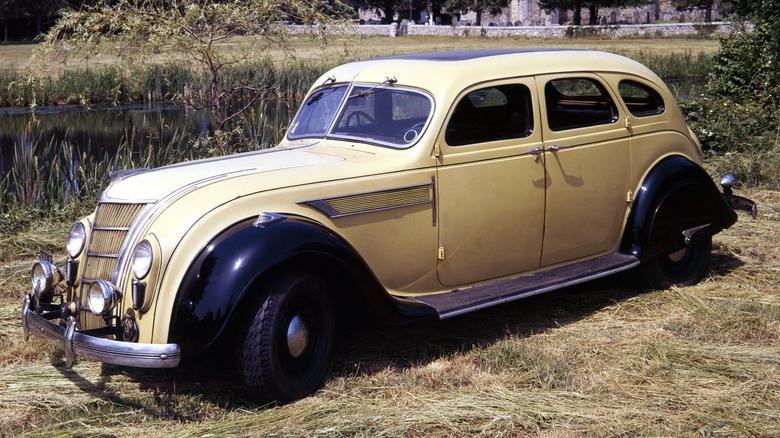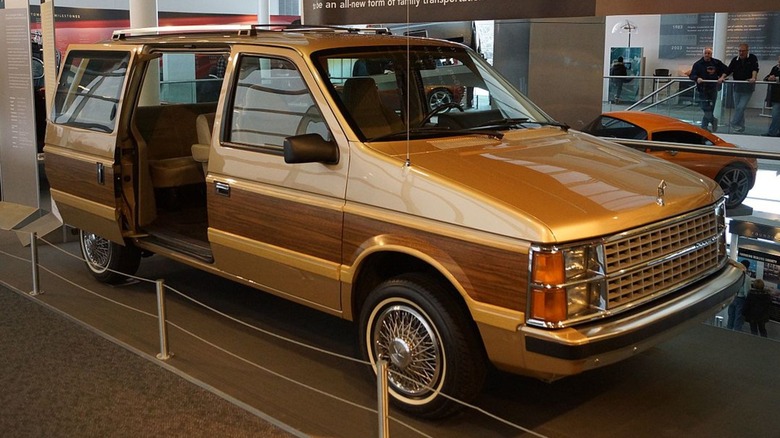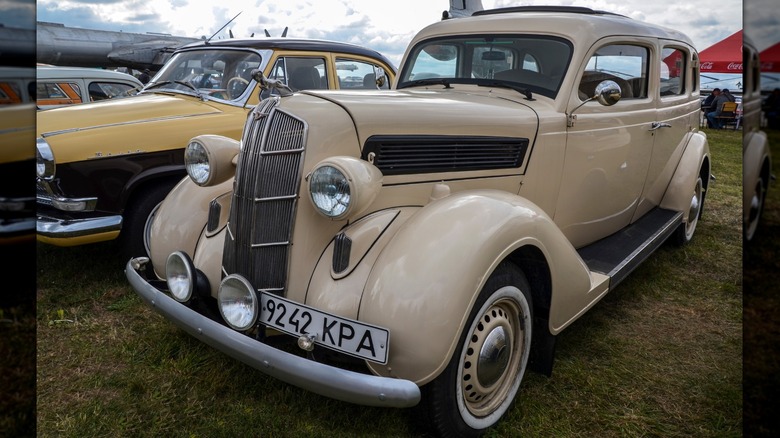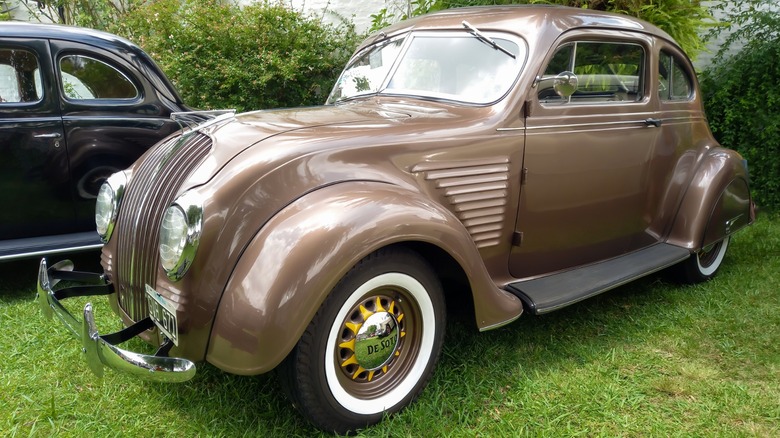12 Car Innovations You Didn't Realize Chrysler Invented
If you follow the industry, you may have read about the woes of automaker Chrysler and its tumbling sales for Jeep, Chrysler, Dodge, and Ram. Inconsistent brand strategies with fewer models are causing inventory backups, while quality issues plague all the brands. Articles from back in 2016 and 2008 — and undoubtedly from even earlier — warn of quality issues dragging on the company's prospects. All this is to say that the automaker currently has some troubles, but they are nothing new. Nonetheless, Chrysler has not always struggled so much. Indeed, the company once powered Detroit with cutting-edge technology, regularly claiming bragging rights for the newest features and breakthroughs.
The first Chrysler automobile debuted in 1924 as a model built by Maxwell Motor Company and named for Walter Chrysler, who had just bought a controlling interest. With proven experience and a knack for the business, he turned his Maxwell investment into a corporate giant and a pillar of American industry. Chrysler knew how to build cars with mass appeal and sought competitive advantages wherever he could find them, leading to dozens of industry firsts through the years. Many, if not most, Americans know of Chrysler's most consequential contribution to the industry: the introduction of the 1984 Dodge Caravan and Plymouth Voyager, beginning the minivan era. Other contributions lay in the shadows of history but have an outsized impact on cars today. Even though it has historically been at the vanguard of product development, it may surprise you that these 12 innovations originate with Chrysler.
Power steering
Not having known a time without the ubiquitousness of power steering, most modern drivers likely take it for granted. Driving an ordinary car without it seems inconceivable. Yet, cars had no power assist for decades. Before 1894, they did not even have steering wheels; drivers used a tiller to control early automobiles. And in antique cars, you may have noticed how large the steering wheels are. Larger wheels provide greater leverage needed for turning cars without power assist.
While the concept existed much earlier, only with the intense production and development required by WWII did power steering get widely adopted, primarily on armored cars and heavy trucks for the military. After the war, Chrysler took advantage of an expired patent to create its Hydraguide power-assisted steering system based on the designs deployed in the war. The first car to receive it was the 1951 Chrysler Imperial, a large luxury car representing the height of American luxury; a 1952 model carried three presidents. As is typical of new auto features, the Imperial's power steering system eventually trickled down to other classes of car and is now standard on nearly everything.
Cruise control
Although it may come as a surprise that Chrysler first introduced cruise control, what is surely astounding is that it was invented by a blind man. Yes, thanks to the University of Pennsylvania's first blind engineering graduate, we can avoid leg cramps on long drives.
Annoyed by the continuous speeding up and slowing down due to his driver's inability to maintain a constant speed, and the rocking it caused, Ralph Teetor, who had already established himself as an accomplished engineer, sought to create something to ease the ride. Beginning in 1936, Teetor formulated ideas on how to solve his problem, testing them in a basement workshop until he had a device he could patent in 1945. Dubbed the "Speedostat" and connected directly to the accelerator, it maintained speed with an electromagnetic lock.
Although Chrysler engineers did not invent the device themselves, it was Chrysler that first recognized its potential and offered Speedostat-equipped cars in 1958. The option Chrysler called "Auto-Pilot" through about 1965 spread to other luxury cars as cruise control before becoming a ubiquitous option across model ranges. It was then further enhanced to arrive full circle as Tesla's Autopilot.
Big data analysis
An extraordinary amount of work goes into producing the cars we buy from dealer showrooms. Thousands of people work thousands of hours long before a single car leaves a transport truck and enters into dealer inventory. It requires meticulous planning by accountants, project managers, and logistics managers, and the way it all works today can be traced back to Walter Chrysler.
Working his way up from being a mechanic, Chrysler moved into management in multiple factories. He joined Buick in 1912 and saw several areas in which the company needed improvement and implemented changes that led to an increase in annual output from 20,000 to 124,000 cars in four years. He learned in previous positions that having current data was crucial to monitor production and eliminate inefficiencies, and used that knowledge to streamline Buick's manufacturing lines.
His success at Buick earned him a position in which he could buy into another automaker and mold it into one of his own, which he did. He employed more of his ideas in building Chryslers, using the largest quantity of the most current data possible to plan products, set manufacturing schedules, and staff his company. His reliance on data made Chrysler a huge success, influencing the direction of other manufacturers to the point that data analysis underpins the entire industry today. Chrysler's data is perhaps the most important unsung innovation of all.
ABS (Anti-Lock Braking System)
If you drive or have only driven cars made in roughly the last two decades, having computer-aided assistance when braking on slippery surfaces is a given. Young drivers likely do not give it much thought at all, especially since they probably have no experience otherwise. However, older drivers will remember distinctly driving cars in which you needed to take great care in applying the brakes to prevent the tires from locking up during an abrupt stop.
The first patent of an anti-lock system for brakes was filed in 1928 by Karl Wessel, but he could not build a functional product. Fast forward to the '60s when a British boutique automaker installed ABS on its Jensen FF, the first car to offer all-wheel-drive. But the system was strictly mechanical and only 320 were built.
The first instance of a car being equipped with electronic anti-lock brakes on all four wheels occurred in 1971 with the Chrysler Imperial and its FourWheel Sure-Brake option. According to a 1972 issue of Popular Electronics, its logic controller was indeed solid state, making it a genuine transistor-based component and part of the digital age. The $350 option was quite expensive, and buyers likely balked at the price while being uninformed or unconcerned with its true benefits to safety. Nonetheless, about 230 cars were sold with it, but it would be many years before the widespread adoption of ABS became standard.
Electronic fuel injection
Modern cars offer excellent fuel economy and reliability in large part thanks to electronic fuel injection. When automakers were able to remove carburetors and install fuel injectors, they resolved multiple issues every car owner dealt with at some time.
Fuel injection development began early on and could be found in diesel engines of the 1930s and every aircraft engine by WWII. Automotive fuel injection came a bit later, first on racing cars and then on the fabulous and highly collectible 1957 Mercedes-Benz 300SL roadster. However, those injection systems were purely mechanical, relying on vacuum and crankshaft rotation to meter fuel, and they required meticulous tuning. Chrysler tried something else.
A year after the Benz debuted, Chrysler offered a system developed by Bendix called the Electrojector. This $400 option looked extraordinarily similar to modern systems, using many of the same components and signals to function. However, since microprocessors did not yet exist, the controller, advertised by Chrysler as the "brain box," consisted of a few transistors and a bunch of analog electrical components, but it was still a mess. That analog computer was also its downfall as failures were immediate and widespread. Chrysler only sold about 54 units, and most of them were soon swapped for a carburetor by the dealer. Chrysler did not revisit fuel injection again for a couple of decades; the Electrojector system went to Bosch and arrived after further development as the D-Jetronic system in a 1968 Volkswagen.
Disc brakes
Most cars in showrooms today come equipped with highly effective power hydraulic disc brakes on all four wheels as standard equipment. Drum brakes of the past suffered from low effectiveness, and Chrysler introduced incredible improvements.
Before the Chrysler Corporation existed, Maxwell-Chalmers built the first Chrysler car, and Walter Chrysler made sure to pack it full of innovation. While other cars came with mechanical brakes, Chrysler introduced the first mass-market passenger car with four-wheel hydraulic brakes using a system initially created by Lockheed for its airplanes. Notably, Duesenberg used hydraulics first, but only on a handful of cars bought by people named Vanderbilt or Rockefeller. Years passed before other automakers widely adopted hydraulics for stopping.
Not content to stop there, Chrysler then introduced the disc brake to passenger cars in 1949. Standard on the 1950 Town & Country and Crown Imperial, the $400 option for other models, about $5,206 today, bears little resemblance to modern disc brakes but functions fundamentally the same. They appeared as drum brakes while concealing dual friction discs putting pressure on disc surfaces machined into both sides of the "drum" housing. Few buyers chose this option, and Chrysler dropped it five years later, introducing caliper-style disc brakes again in 1966.
Oil filter
Early automobile engines came with no oil filtration whatsoever. The primary way to keep the oil clean was to replace it every 500 to 2,000 miles. Some engines very early on, such as the flathead V-twin used on Harley-Davidson motorcycles, utilized a total loss oiling system, meaning oil fed to the engine from a tank simply dripped out of it and onto the ground. Engines developed with more advanced lubrication systems required some sort of filtration to prevent contaminants from clogging oil passages and pumps. Various reusable types of wire mesh, screens, or steel wool designs first attempted to filter the oil, but still allowed too much contamination. However, a solution arrived in 1923.
Using a series of twill-weave cloth-covered plates inside a heavy-duty canister, Ernest Sweetland and George J. Greenhalgh developed the first modern oil filter. With it delivering "pure oil later," the pair chose to call it the Purolator filter. Recognizing its potential, Maxwell-Chalmers installed one in a car for testing on an extended drive. It just so happens that Walter Chrysler entered the picture that year and added it to his new eponymous car, making it the first passenger vehicle with a replaceable oil filter. The trend was quickly adopted by the rest of the industry.
The talking car
The 1980s were a great time for technology. With microprocessors and computers becoming small enough to put into portable machines, their use spread into multiple industries, including automotive. And while computer controls for engines make for practical use of processing power, engineers managed to find more trivial purposes.
Nearly anyone alive back then can tell you about the wonderfully quirky yet incessantly annoying talking cars. Select models, usually also equipped with new digital dashboards, signaled the car's alerts with an audible voice. This feature debuted in Nissan vehicles in 1981 while Chrysler lagged behind with its first model in 1983. However, there was a big difference between the two. Nissan's system packed tiny records into a box that could be triggered individually depending on inputs from the car like a tiny record player on demand. Chrysler's unit actually spoke with a less refined voice because it was done with a digital synthesizer and no recordings.
The Chrysler Electronic Voice Alert (EVA) used solid state circuitry to create voices on demand based on inputs and included 11 messages from everything from an open door to low oil pressure. Developed in conjunction with Texas Instruments, it operated on the same technology as the company's Speak & Spell toy. Chrysler turned out to be a leader once again as Nissan adopted digital technology for its voice alert in 1985. Nonetheless, we all should be grateful that the talking car concept quickly went out of vogue, if it was ever in vogue to begin with.
Wind tunnel testing
The idea of designing a car solely based on how it looks and guessing that it will cut through the wind well enough seems foreign and bizarre today. But in the early days, nobody had ever taken the time to think about it. After all, they had no access to curved glass and it took some time to even have bodies that stretched to the entire perimeter of the chassis. Eventually, someone took notice and did something about it.
Carl Breer headed engineering at Chrysler from the start and created many of the innovations that set the nascent company apart. But after a few years and with growing success for the automaker, Breer came up with a concept for a new car and tested its designs before production. Inspired by the image of Army planes flying over his home, Breer wanted to study how air flowed over cars. To do so, he built the world's first wind tunnel for testing automobile designs only to discover terribly inefficient airflow around his cars. He discovered air actually flowed more freely with the car in reverse. This realization guided the design of his next car.
After more study and plenty of work to mold a shape that allowed for less disruption in airflow, Breer created the 1934 Chrysler Airflow. Its curvy shape slipped seamlessly through the wind as a picture of efficiency and introduced several other new features. However, the public was unprepared for such a radical design, and for that reason, plus a scandalous smear campaign by rival GM, the car flopped. Regardless, wind tunnel testing remained and became a crucial part of car design still used today.
Cup holders
Such a universal but useful feature in all new cars that most people probably hardly ever think of is the cup holder. They are seemingly indispensable, particularly for busy people on the go, and they come in a wide variety and quantity, too. The Subaru Ascent has a total of 19 while the Mercedes eSprinter offers a ridiculous four per person. But not so long ago, cars offered zero space dedicated to lattes and Big Gulps, and it made having drinks on the go a huge hassle, if not impossible.
An entire range of aftermarket cup-holding accessories was developed for the purpose, but these came with varying degrees of usefulness. The 19077 Chevy Blazer offered an optional center console with molded cup holders, but they went away after a couple of years. Ever at the cutting edge and willing to give its customers what they want, Chrysler built the first vehicle to offer permanent cup holders as standard features across the entire range. In the back of the groundbreaking Caravan of 1984 along the left side of the passenger area were two cup-shaped spaces molded into the armrest. With certain upholstery packages, access became limited, making only very small cups fit, but they were still bona fide cup holders. Perhaps most of all, this is the greatest trend ever started by the Auburn Hills company, and we should all be thankful for it.
Rubber engine mounts [See Update]
In the infancy of the automotive industry, automakers installed engines into cars resting on metal mounts. While solid and sturdy, these transferred every bit of vibration to the chassis, ensuring every occupant could feel the harshness of the engine along with whatever they felt from primitive suspensions and underdeveloped seating. Once again, Chrysler was the first with an effective solution, and it solved problems two-fold.
The biggest change implemented in 1932 was the use of solid rubber to make the engine mounts. With a little cushion, the vibration could be isolated from the engine and prevented from transferring to the occupants, making for a much smoother and more pleasurable driving experience. Additionally, Chrysler developed its "Floating Power," using just two rubber mounting points to position the engine such that it is well-balanced within the frame while being allowed to rock slightly and intersect with its center of gravity, preventing its natural vibration from traveling through the chassis. This excellent example of an early engineering solution to a real-world problem set the young Chrysler Corporation apart from the competition.
UPDATE: The very first example of the rubber mounting of an engine in an automobile was prototyped by one Joseph Ferguson in the year 1914 in Belfast, Ireland. A U.S. Tax Court document filed in October of 1966 shows the vehicle "1914 Irish Fergus" as the first example of rubber mounts for an automobile engine. This document also shows that Chrysler "paid for consultation concerning the rubber mounting of the automobile engine as originated on the 1914 Irish Fergus."
Downdraft carburetor
Details of the minutiae of carburetor design and effectiveness likely only interest the genuine car nerds among us, but developments in carburetor design along the way have created the conditions in which the cars all of us enjoy today can exist. And before the widespread adoption of fuel injection, nearly all cars had a carburetor.
The first reliable and practical carburetor design widely implemented by automakers was known as an updraft carburetor. In this configuration, air enters at or near the bottom of the carburetor's body to rush past a jet and mix fuel and air before entering the intake of the engine. These were simple devices that improved function and reliability over the primitive designs preceding them, prevented flooding, and were generally placed low on the engine for gravity-fed fuel from the tank.
In 1929, Chrysler opted to install all-new Stromberg downdraft carburetors on the 1930 models. Holley Carburetor Company initially spoke with engineer Carl Breer in 1928 about switching to the new design, but Breer was concerned about flooding. Later, Stromberg altered the design by adding a float valve to shut off the fuel supply when the bowl was full, so Breer gave it the green light for production, making Chrysler the first to adopt it. This may seem like an insignificant footnote, but the downdraft carburetor design allowed for simplified and cost-effective manufacture of V8 engines going forward. But for Chrysler, it is simply another first of many to come from decades of Chrysler's successful innovation.
